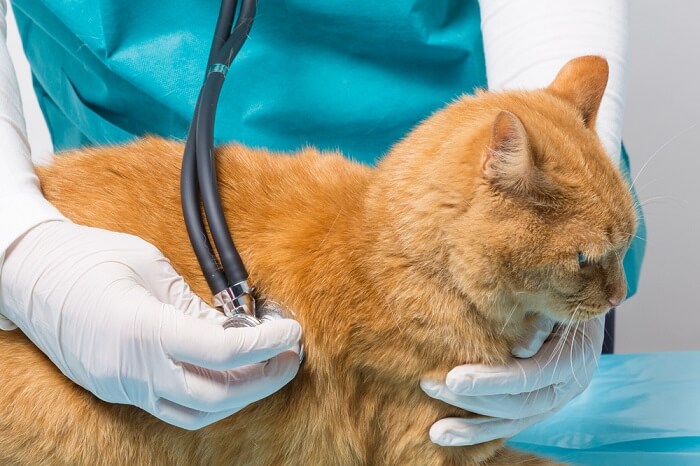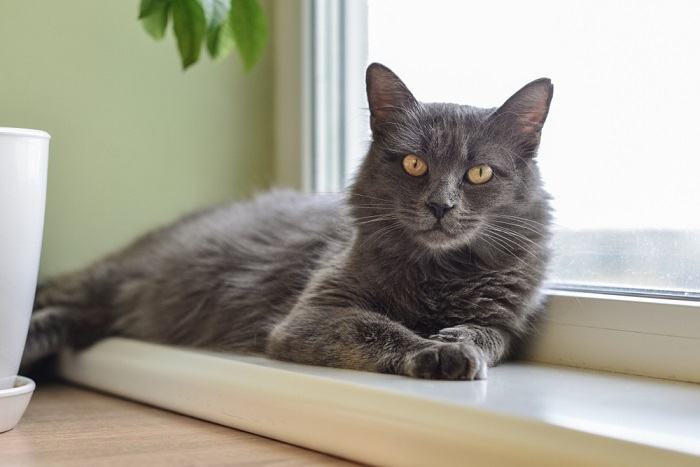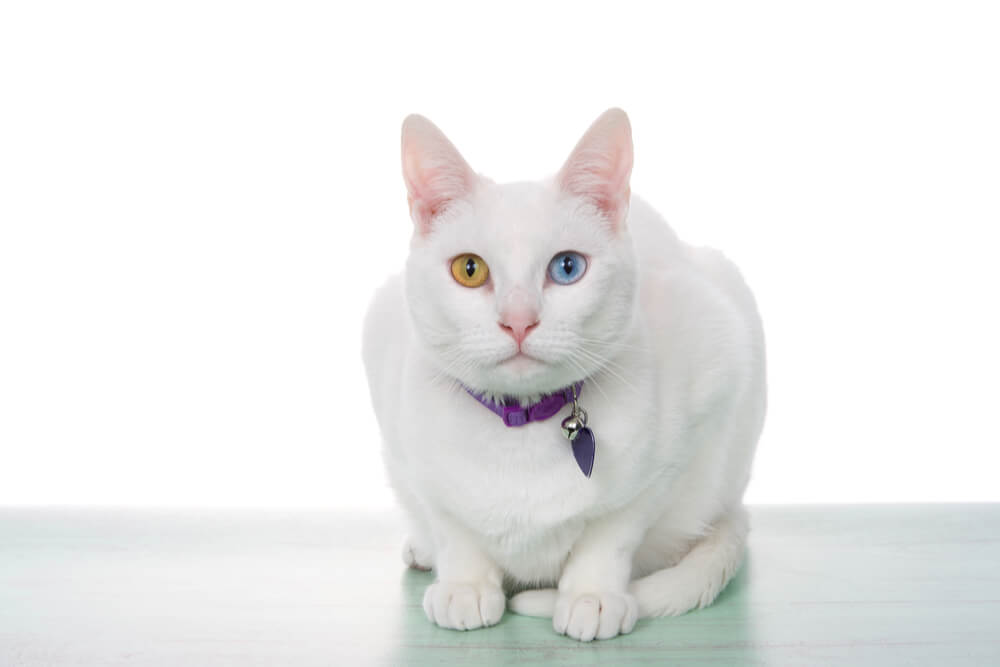How Long Can A Cat Live With Lung Cancer

Like in humans, lung cancer in cats can be extremely serious, and as a pet owner, information technology can be a very scary fourth dimension. Knowing what symptoms to look for and what happens afterward diagnosis will mean you lot're completely prepared if your true cat is diagnosed with a lung neoplasm.
Quick Overview: Lung Cancer In Cats







What Is Lung Cancer In Cats?

'Cancer' ways an abnormal proliferation of cells- they grow and increase in size and number and are immune to the torso'southward usual 'stop' signals. 'Tumors' form as these cells grow into a large lump.
Lung cancer (properly called pulmonary neoplasia) is whatsoever sort of tumour that grows in the lungs. This can cause a big problem, every bit the tumour takes upwardly space that the lungs need in guild to piece of work effectively.
Types Of Lung Cancer In Cats

Lung cancer in cats may be classified equally "primary lung cancer", which refers to tumors that started in the lungs, or "secondary lung cancer", which refers to cancer that started somewhere else and spread to the lungs.
Primary Lung Cancer
Tumors that grow in the lungs outset, rather than metastasize there from elsewhere in the body, are called 'primary' lung tumours.
They are fairly rare in cats, bookkeeping for less than ane% of cancer cases in cats- although these types of tumour are on the increase.
Primary lung tumours usually impact older cats (average historic period 12 years), and may be more common in Farsi cats.
The most mutual main lung tumour in cats is pulmonary adenocarcinoma, which can ascend from the bronchus (the tubes that carry air into the lungs) or from the alveolae (the air sacs). Squamous cell carcinoma and bronchioalveolar carcinoma are other types of cancer that occur in cat lungs.
Primary lung tumours are ofttimes malignant, with around iii quarters metastasizing to other parts of the body such as the lymph nodes, bone, or liver. Feline lung-digit syndrome is mutual- this is where the lung tumour spreads to the toes, causing swelling and lameness.
Although this swelling is sometimes the first symptom of lung cancer in cats, the cancer is oftentimes very far advanced past this stage and the prognosis is unfortunately very poor for cats with lung-digit syndrome.
Secondary Lung Cancer
Many cancers spread to the lungs from elsewhere in the body, and we call this a 'secondary' lung tumour or 'metastatic lung tumour'. Almost whatever malignant tumour type can metastasize to the lungs, although lymphoma, mammary cancer and bone cancer (osteosarcoma) are some of types of cancer that are most likely to spread to the lungs.
Because so many tumours metastasize to the lungs, secondary lung cancer is much more common than main lung cancer.
Causes Of Lung Cancer In Cats

The verbal causes of lung cancer in cats are poorly-understood. Information technology's suggested that retroviruses and exposure to environmental tobacco smoke may be risk factors, but we don't know anything definitive.
The causes of lung cancer in cats are poorly understood. Nosotros know that the number of cases is increasing, only information technology isn't clear if this is due to longer life expectancy, better awareness, increased funds for investigation, better imaging techniques, genetics, or exposure to a higher number of carcinogens. It's likely it'southward a combination of factors.
One suggestion is that retroviruses such as FeLV and FIV may accept some bear on on a cat'south lung cancer risk. Some lung cancers in other species are spread by retroviruses, and nosotros know that FeLV increases the risk of lymphoma. However, there's no evidence that this is the case for primary lung tumours in cats at present.
Read More: Feline Leukemia Virus: Causes, Symptoms, & Treatment
Equally in people, it's possible that exposure to cigarette smoke (environmental tobacco fume) could be a gamble factor for lung tumours in cats. Although in that location is currently no direct testify for this, nosotros know that passive smoke inhalation increases the risk of some oral tumours in cats, and that passive smoking increases the take a chance of lung tumours in humans and dogs.
In fact, in some ways, cats are in more than danger from second-hand smoke- they can ingest the toxins when preparation.
Symptoms Of Feline Lung Cancer

A cat coughing doesn't ever necessitate a trip to the vet, but in some cases, a vet visit may be essential. Your vet can aid you lot to identify and resolve the underlying crusade of your cat's coughing.
Lung tumours in cats are oftentimes asymptomatic- cats are masters at hiding signs of trouble and may show no symptoms of lung cancer for a long time. In fact, it'due south estimated that around a third of lung tumours are institute when x-raying for another reason.
When cats practise show signs, difficulty breathing (dyspnea) is common- every bit is fast breathing (tachypnea). Panting, abdominal effort when animate, wheezing, coughing, and inability to exercise are as well signs of lung tumours in cats.
Thanks to lung-digit syndrome, lameness caused by swelling of several toes, or discharge from the blast beds, can likewise be clinical signs of lung cancer in cats.
Other symptoms of lung cancer include:
- Cough
- Do intolerance
- Panting
- Lethargy
- Vomiting
- Inappetence (anorexia)
- Weight loss
- Lameness
- Discharge from nail beds
- Wheezing
- Fever
- Drinking more than than usual
- Urinating more than usual
- Pilus loss
If your veterinarian suspects lung cancer, the kickoff affair they will do is conduct a total concrete exam, including listening to the chest. Bloodwork (biochemistry and hematology) often follow, to assess any changes to organs that may indicate whether the cancer has spread.
This also helps to assess the safety of anesthesia. Imaging- with chest 10-rays, or with CT scans- is side by side. This helps your veterinarian to make up one's mind the size of the tumour and may reveal metastases.
In one case the tumour has been located, the next step is to locate evidence of metastases. With three quarters of lung tumours spreading, your vet will want to notice out where the tumour has spread to in order to requite a prognosis and treatment plan.
The tumour may need to be sampled, and lymph nodes in the surface area should be checked, as these are common sites of metastasis. These samples are usually collected by fine needle aspiration (FNA) also known every bit 'needle biopsy', and the cancer cells sent to a pathologist at a specialist lab for cytology (analysis).
If the FNA doesn't requite enough information, a larger biopsy of lung tissue tin be taken nether an anesthetic for histopathology.
Lung Cancer In Cats Treatment

Unfortunately, the prognosis for lung cancer is often poor, significant that treatment may be palliative rather than focused on curing the affliction.
Unfortunately, lung cancer in cats carries a poor prognosis, and handling is oft 'palliative'- to reduce symptoms, rather than cure the disease. Your veterinarian will talk over the handling options with a veterinarian oncologist to decide the best course of activity for your cat.
Surgical removal of the primary lung tumour or lung lobe is possible, especially if no metastases have been detected. This involves a 'thoracotomy'- major open up-chest surgery that is ordinarily only offered at specialist centers due to the loftier risks involved. If metastases are present, surgery like this is unlikely to bring plenty benefit to make the high-adventure procedure worthwhile.
Chemotherapy and radiotherapy (radiation therapy) is sometimes recommended, peculiarly where metastatic spread has already happened.
If the tumour has caused a pleural effusion, this tin be drained to provide some relief.
Conclusion

Lung tumours in cats are rare simply cases are on the increase, so information technology's worth being enlightened of the signs. As with all tumours, the sooner they're identified the better, merely it's worth being prepared for bad news- lung tumours often have a poor prognosis, especially in one case the disease has spread.
Often Asked Questions
How long can cats live with lung cancer?
Unfortunately, average lung cancer survival fourth dimension is less than six months, although it can be over a year if the tumour is detected before it metastasizes. The prognosis is worse with lung-digit syndrome, with survival time averaging just a couple of months. Cats are usually euthanized due to their metastatic affliction.
Is lung cancer painful for cats?
Vets are not sure if lung cancer is painful for cats, as they hibernate it then well. We know that one in 5 humans with lung cancer written report pain, and information technology seems probable that lung cancer can be painful for cats, also. Metastases tin be painful, especially to the bones or in lung-digit syndrome.
What are the symptoms of lung cancer in cats?
The signs of lung cancer in cats are oft subtle or not-existent. When signs do exist, panting, languor, weight loss, and toe swelling are mutual.
Can lung cancer in cats be treated?
If caught early, information technology'south theoretically possible for lung cancer to be treated. Withal, almost cases go undetected until a late stage, and 'treatment' is usually palliative with the aim of reducing symptoms and improving quality of life. Feline lung cancer is eventually fatal in about cases.
Source: https://allaboutcats.com/lung-cancer-in-cats
Posted by: donohueyoulle64.blogspot.com

0 Response to "How Long Can A Cat Live With Lung Cancer"
Post a Comment